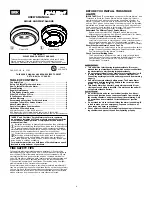
ENFORCER 300C/L
Installation Manual
ENFORCER 300C/L
Installation Manual
SECO-LARM U.S.A., Inc.
TABLE OF CONTENTS
General considerations ............................. 3
Mounting the alarm brain ......................... 4
Differences between E-300C/300L ............ 4
Wire Connections:
8-pin connector
RED wire (+12 volts) ............................ 5
BLACK wire (ground) ............................ 5
PINK wire (siren) .................................. 5
3 x ORANGE wires (parklights) ............. 5
BROWN/BLACK wire (2nd unlock) ........ 6
BROWN/WHITE wire (channel 3) .......... 7
6-pin connector
BLACK/WHITE wire (channel 2) ............ 7
GRAY/BLACK wire (domelight) .............. 7
BLUE wire (neg door switch) ................. 7
PURPLE wire (pos door switch) .............. 8
BLUE/WHITE wire (hood/trunk) ............. 8
YELLOW wire (ignition switch) ............... 8
Starter disable (2-pin, WHITE wires) ........... 9
LED (2-pin RED connector) ........................ 9
VELT push button (2-pin WHITE connector) 9
Dual-stage shock sensor (4-pin connector) 9
Connection diagram ............................... 10
Dual-stage glass-break sensor (cable jack) 12
Power door locks (3-pin connector) ........... 13
Current sensing ....................................... 16
Specifications .......................................... 16
Alarm feature programming .................... 17
VELT button functions ............................... 17
Learning the transmitters (E-300C/300L) .. 19
Tips for testing the alarm ......................... 19
Troubleshooting guide ............................. 20
NOTICE
The information and specifications printed in this manual are current at the time of publication.
However, the SECO-LARM policy is one of continual development and improvement. For this
reason, SECO-LARM reserves the right to change specifications without notice. SECO-LARM is
also not responsible for misprints or typographical errors.
Copyright © 2001 SECO-LARM U.S.A., Inc. All rights reserved. This material may not be
reproduced or copied, in whole or in part, without the written permission of SECO-LARM. This
vehicle security system is protected by patents in the U.S.A., Great Britain, Germany, Hungary,
Taiwan, China, Japan, and Korea. Other U.S.A. and international patents are pending.
A. Testing RF reception and range — To test if
the alarm brain is receiving signals from the
RF transmitter, and to test range, watch the
alarm status LED. The LED should turn on
steady as long as any button on the RF
transmitter is being pressed. If the LED does
not turn on, this means the alarm brain is
not receiving the transmitter signal.
B. Testing wire connections — Often, when
trying to trace a problem between a
trigger input, wiring, and the alarm brain,
one place to test is at the alarm brain
itself. Set the VOM for (+) or (-),
depending on the trigger, then probe the
appropriate wire near the alarm brain
while testing the trigger. For instance, to
determine why a (-) door trigger is not
TIPS FOR TESTING THE ALARM
working, probe and test the BLUE WIRE of
the 6-pin connector near that connector. If
the BLUE wire shows (-) when the door is
opened, then the problem may be caused
by the user not arming the alarm correctly,
or the alarm brain may be defective. But if
the BLUE wire does not show (-) when the
door is opened, the problem may be a
loose or defective pin switch or wire
connection.
C. Sensor delay times — The various sensors
have a short 4-second delay from the time
the alarm is armed until the sensor can be
triggered. Therefore, after arming the
alarm, wait until after the delay period
before testing the sensor to be sure that
sensor is operating properly.
Page 2
Page 19
The alarm can learn a max. of 4 remotes. RF
Code Wash™ deletes all previous remotes
when any new remote is learned. This prevents
unauthorized use of lost or stolen transmitters,
and alerts the user if someone has secretly
code learned a new transmitter. However, it
also means that, when code learning is being
done, ALL THE USER'S TRANSMITTERS MUST
BE CODE LEARNED AT THE SAME TIME.
A. Procedure:
(1) Disarm the alarm.
(2) Open a car door.
(3) Turn the ignition switch on and then off
three times.
(4) Press the VELT button three times
within 15 seconds of turning the
ignition off the third time. The siren
chirps once.
(4) Within 15 seconds, push button #1 of
the first transmitter to be learned. At this
time, all previous codes are deleted,
and the alarm learns this transmitter's
code. 1 chirp confirms code learned.
(If no button is pressed within this 15-
second period, code learning is exited,
and old codes are retained.)
(5) Within 15 seconds, push button #1 of
the second transmitter to be learned (if
applicable). 1 chirp confirms learned.
(6) Repeat step (5) until all transmitters are
learned. The siren chirps once for
each transmitter when its code is
successfully learned.
B. Exit the code learning procedure — The
alarm chirps the siren two times, exits the
code learning mode, and is disarmed after
learning the fourth transmitter's code, or if
you turn the ignition switch on, or if you do
nothing for 15 seconds.
C. Enforcer 300C vs. Enforcer 300L — The
Enforcer 300C uses SECO-LARM's
CODEBUMP™ code-hopping system. All
transmitters come coded by the factory,
and cannot be recoded by the installer or
user. The Enforcer 300L uses fixed-code
transmitters.
LEARNING THE TRANSMITTERS (E-300C/L)




























